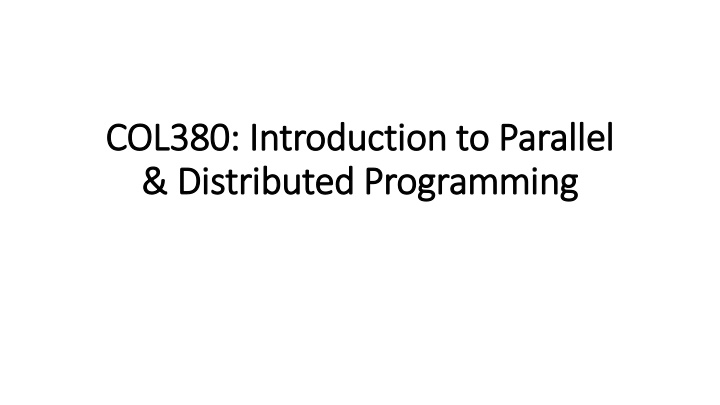
Exploring Parallel and Distributed Programming Concepts
Delve into the world of parallel and distributed programming through the study of concurrency, parallelism, and distributed computing. Learn about Moore's Law, CPU trends, benefits of parallelism, and the potential of parallel computing. Discover how parallelism can enhance computation power in various applications such as climate modeling, protein folding, and data analysis.
Download Presentation

Please find below an Image/Link to download the presentation.
The content on the website is provided AS IS for your information and personal use only. It may not be sold, licensed, or shared on other websites without obtaining consent from the author. If you encounter any issues during the download, it is possible that the publisher has removed the file from their server.
You are allowed to download the files provided on this website for personal or commercial use, subject to the condition that they are used lawfully. All files are the property of their respective owners.
The content on the website is provided AS IS for your information and personal use only. It may not be sold, licensed, or shared on other websites without obtaining consent from the author.
E N D
Presentation Transcript
COL380: Introduction to Parallel COL380: Introduction to Parallel & Distributed Programming & Distributed Programming
We will Study We will Study Concurrency Parallelism Distributed computing
Evaluation Evaluation Assignments Minor-1 Minor-2 Major 40%, 15%, 15%, 30% Plagiarism is unacceptable. Offenders will be penalized by a failing grade.
Moores Law Moore s Law the number of transistors in a dense integrated circuit (IC) doubles about every two years. Ref: https://www.britannica.com/ technology/Moores-law
CPU Trends CPU Trends
CPU CPU Trends Trends
Sequential Computation Sequential Computation Bottleneck of Sequential Computation Single processor performance increases with the as transistor density increases. Increase in transistor density increases power consumption and result in heating problem. Heating problem results in unreliable computation. Additional technique to improve performance:Parallelism
Benefits Benefits Parallelism increase computation power Many important applications Climate modeling Protein folding Drug discovery Data analysis
Parallelism and Parallel Computing Parallelism and Parallel Computing Can a system automatically parallelize a sequential program? Specific cases Automatic parallelization by compiler Instruction level parallelism in architecture Cannot exploit all possible opportunities Parallel Programming: Device parallel algorithm and program that solves a problem in more efficient manner
Example Example Problem: Compute n values and sum them together. Sequential Program int sum = 0; for (i = 0; i < n; i++) { x = f(i); sum = sum+x; }
Parallel Program: Compute Partial Sum Parallel Program: Compute Partial Sum Assumption: p processors where p << n my_sum = 0; my_first i = . . . ; my_last i = . . . ; for (my_i = my_first i; my_i < p_last_i; my_i++) { my_x = f(i); my_sum += my_x; }
Parallel Program: Accumulate Partial Sum Parallel Program: Accumulate Partial Sum if(I m the master core) { sum = my_sum; for(each core other than myself) { receive value from core; sum += value; } } else{ send my_sum to the master; } 8+19+7+15+7+13+12+14 =95
Parallel Program: Second Attempt Parallel Program: Second Attempt No constraint on the number of available processors
Comparing two Attempts Comparing two Attempts (1) Compute partial sum of n/p elements. (2) accumulate results of partial sum Both approaches have same number of addition operations
Comparing two Attempts Comparing two Attempts Parallel computation (1) Compute partial sum of n/p elements. Serial computation (2) accumulate results of partial sum Step (2) of the first approach is serialized
Comparing two Attempts Comparing two Attempts (1) Compute partial sum of n/p elements. (2) accumulate results of partial sum First approach is closer to the sequential sum program
Additional Concerns Additional Concerns Communication - shared memory, message passing, Coordination - synchronization Job distribution - load balancing
Different Models of Computation Different Models of Computation Concurrency Shared memory programs: OpenMP Parallelism Message passing: MPI . Distributed computing
Memory & Communication Play a Significant Role Memory & Communication Play a Significant Role Core 1 Core 0 Core 1 Core 0 Memory Memory Memory Network
References References Chapter 1 An Introduction to Parallel Programming by Peter Pacheco. Introduction to Parallel Computing, Second Edition by Ananth Grama, Anshul Gupta, George Karypis, Vipin Kumar












